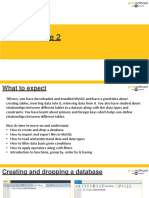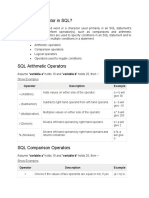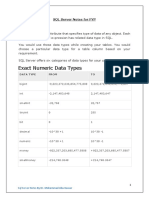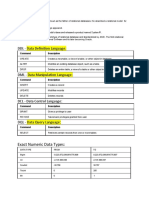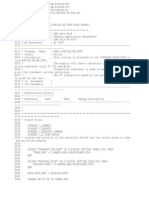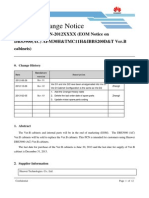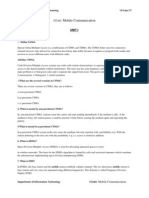ANSI SQL
SQL Operators
LEVEL LEARNER
�Icons Used
Hands-on Exercise
Coding Standards
Reference
Lend A Hand
Questions
Summary
Points To Ponder
Test Your Understanding
�Overview
This session on SQL operators, provides knowledge and
understanding on the use of operators available in
ANSI. It also demonstrates the application of the syntax
learned as part of this session in a case study provided.
This session on SQL operators, provides knowledge and
understanding of the use of operators available in ANSI. It
also demonstrates the application of the syntax learned as
part of this session in a case study provided.
3
�Objectives
After completing this session, you
will be able to:
Describe the Arithmetic operators.
Describe the Comparison operators.
Describe the Logical operators.
Describe the Set operators.
�Scenario
To understand ANSI SQL in detail, we are going to make use of Product
Management System (PMS), for ABC Traders.
ABC Traders is a company that buys collectible model cars, trains, trucks,
buses, trains, and ships directly from manufacturers and sells them to
distributors across the globe. In order to manage the stocking, supply and
payment transactions, this software is developed.
As per the requirement of the trading company, an inventory system is
developed to collect the information of products, customers, and their
payment processing.
�Database Tables
There are many entities involved in Product Management System.
Here are the entities, which we will be dealing with throughout this course:
Offices
To maintain information
of Offices.
For instance: Office
code, address, city, and
so on.
Customer
To maintain customer
details.
For instance:
Customer Name,
address, and so on.
Payments
To maintain information
of payments done.
For instance: Payment
date, amount, and so
on.
Employees
To maintain employee
details.
For instance: ID,
Name, and so on.
Orders
To maintain Orders
done by customers.
For instance: Order
no., date, and so on.
Products
To maintain
information of
products.
For instance: Product
ID, name, and so on.
Order Details
To maintain Orders
done by customers.
For instance: Order
no., date, and so on.
�Schema Diagram
�SQL Operators
Hi!
Now that you have created tables
and applied constraints to tables, I
would want you to take care of
some requirements, which involve
adding data from two columns and
display it in single column.
To help us meet Tims requirements, let us learn about arithmetic operators.
�SQL Operators
What are SQL Operators?
An SQL Operator is used for processing data values (stored
in columns of tables) after which it returns a result. The
data values are called operands.
SQL Operators are represented by special characters or by
keywords.
The operators supported by ANSI SQL are listed below:
Arithmetic operators
Comparison operators
Logical operators
Set, Union, Intersect & Minus Operators
�Arithmetic Operators
Arithmetic Operators:
Arithmetic operators are used to manipulate numeric operands, which are columns
storing numeric values.
Types of arithmetic operators:
Monadic Arithmetic Operators, which are namely,
+ and Dyadic Arithmetic Operators, which are namely,
/,
*,
+, and -.
Rule:
If the value of any operand in a numeric value expression is null value,
then the result of that numeric value expression is the null value.
10
�Arithmetic Operators
Here are some examples of the arithmetic operators:
Operator
11
Description
+(monadic)
Makes operand positive
-(monadic)
Makes operand negative
Example
SELECT + Creditlimit
FROM Customers;
SELECT - Creditlimit
FROM Customers;
Division(Used with Number and Date)
SELECT Creditlimit / 10
FROM Customers;
Multiplication
SELECT Creditlimit * 10
FROM Customers;
Addition (numbers and dates)
Subtraction (numbers and dates)
SELECT Creditlimit + 1000
FROM Customers;
SELECT Creditlimit - 500
FROM Customers;
�Scenario
Hurray!
You have understood my requirement
and provided the solution!
My next requirement is to find the
customers whose credit limit is in the
range between 10000 and 15000.
Lets learn about comparison operators which will help us meet Tims requirements..
12
�Comparison Operators
Comparison Operators:
Comparison operators are used in conditions that compare one operand with
another. The result of a comparison can be TRUE (or) FALSE (or) NULL.
13
Types of comparison operators:
Comparison operator
Name
equals operator
!=, <>
not equals operator
<
less than operator
>
greater than operator
<=
less than or equals operator
>=
greater than or equals operator
�Comparison Operators
14
Operators
Syntax
between predicate
[ NOT ] BETWEEN <row value predicand>
AND <row value predicand>
in predicate
[ NOT ] IN <in predicate value>
character like predicate
[ NOT ] LIKE <character pattern>
[ ESCAPE <escape character> ]
null predicate
IS [ NOT ] NULL
exists predicate
EXISTS <table sub query>
quantifier
<all>| <some>
all
ALL
some
SOME| ANY
�Comparison Operators
The comparison operators displayed below are used in conditions that compare one
operand with another. The result of a comparison can be TRUE (or) FALSE.
Operator
15
Description
Example
Equality Test
SELECT CustomerName
FROM Customers
WHERE Country =USA;
!=, <>
Inequality Test
SELECT CustomerName
FROM Customers
WHERE Country !=USA;
>
Greater than test
SELECT CustomerName
FROM Customers
WHERE creditLimit > 5000;
<
Less than test
SELECT CustomerName
FROM Customers
WHERE creditLimit < 10000;
>=
Greater than or equal to test.
SELECT CustomerName
FROM Customers
WHERE CreditLimit >= 5000;
<=
Less than or equal to test.
SELECT CustomerName
FROM Customers
WHERE CreditLimit <= 10000;
�Comparison Operators
The comparison operators displayed below are used in conditions that compare a
particular value to each value in a list.
Operator
IN
NOT IN
16
Description
Equivalent to comparing the operand
value with a list of values and if any
match happens it returns true.
Equivalent to comparing the operand
value with a list of values and if any
match happens it returns true.
Example
SELECT CustomerName
FROM Customers
WHERE Country IN (USA', Norway');
SELECT CustomerName
FROM Customers
WHERE Country
NOT IN (USA', Norway');
�Comparison Operators
Operator
Description
Example
BETWEEN AND
Checks whether the operand
value falls within a range. A
range can be defined with lower
and upper limits
SELECT CustomerName
FROM Customers
WHERE CreditLimit
BETWEEN 10,000
AND 15000; // selects customer name whose
credit limit between 10000 and 15000. it also
includes the value 10000 and 15000.
NOT BETWEEN
AND
Checks whether the operand
value does not falls within a
range. A range can be defined
with lower and upper limits
SELECT CustomerName
FROM Customers
WHERE CreditLimit
NOT BETWEEN 10000
AND 15000; // selects customer name whose
duration NOT between 10000 and 15000. it
also includes the value 10000 and 15000.
17
�Comparison Operators
Operator
LIKE/NOT
LIKE
Description
Example
SELECT CustomerName
The LIKE operator is used for wild
FROM Customers
card matching.
% used for multiple or no character. WHERE CustomerName
LIKE '%Gift Stores;
//Select Customers whose name ends with Gift Stores
Example: SIGNAL GIFT STORES.
LIKE
/NOT LIKE
The LIKE operator is used for wild
card matching.
_ is used for single character.
SELECT CustomerName
FROM Customers
WHERE CustomerName
LIKE Herkku Gift_;
//Select customers whose name starts with Herkku Gift
and ends with one character after it.
IS NULL/
IS NOT
NULL
18
Tests for nulls. This is the only
operator that should be used to
test for nulls.
SELECT CustomerName
FROM Customers
WHERE CustomerName
IS NOT NULL
AND Creditlimit <= 10000;
// returns all records which has credit limit <= 10000 and
customer name is not null
�Scenario
Hurray!
The requirement is
completed. Thanks for
solving this problem!
19
�Check Your Understanding
Now let us answer these questions in order to test our learning.
Requesting all associates to reflect the following before proceeding.
What is the operator used for checking whether an age
falls in the range between 10 and 60?
What is the operator used, to check if a name starts with
"An"?
What is the operator used, to check if a column values
meets all the values in a list or a sub-query?
How does one check if a column is null?
20
�Problem Scenario
Hi!
Can you provide me with a
query which will get the
customer details of clients
who are not just from
London but also from UK?
Lets learn about logical operators which will help us meet Tims requirements.
21
�Logical Operators
Logical operator
Logical operators are used for manipulating the results of one or more conditions.
In SQL, all logical operators evaluate to TRUE, FALSE, or NULL (UNKNOWN).
Types of comparison operators:
Operator
NOT
AND
OR
22
Description
Returns TRUE if the condition returns FALSE. Returns FALSE if the
return values is TRUE.
Used to combine two conditions. Returns TRUE if both condition are
met. Returns FALSE if either of it is FALSE.
Returns TRUE if one of the condition returns TRUE. Returns FALSE if
both are FALSE.
�Logical Operators
Example: If age > 45 AND salary < 4000.
Here, And is the operator used to combine the results of the both the conditions and
returns a result.
Operator
NOT
Example
Result
SELECT CustomerName
FROM Customers
WHERE NOT (Creditlimit IS NULL);// Retrieves the customer names who
has a creditlimit assigned.
Atelier graphique
.
AND
SELECT CustomerName
FROM Customers
WHERE Country = UK'
and City = London'; // Retrieves the customer names who has country UK
and their city is London.
Stylish Desk Decors,
Co.
Double Decker Gift
Stores, Ltd
OR
SELECT CustomerName
FROM Customers
WHERE Country = UK'
OR City = London'; // Retrieves the customer names who has country UK
(OR) their location is London.
23
AV Stores, Co.
UK Collectables, Ltd.
giftsbymail.co.uk
Stylish Desk Decors,
Co.
Double Decker Gift
Stores, Ltd
�Scenario
Hi!
Can you provide a
solution to how we can
get the unique country,
and state, from two
tables.
Lets learn about set operators which will help us meet Tims requirements..
24
�Set Operators
Set operators combine the results of two queries into a single result.
The two queries can be a select query from a same table or from different tables.
The different types of Set Operators are given below.
25
Operators
Description
UNION
Returns all distinct rows selected by both the queries
UNION ALL
Returns all rows selected by either query, including all
duplicates
INTERSECT
Returns all distinct rows selected by both queries
MINUS
Returns all distinct rows selected by the first query but not the
second
�Rules of Set Operators
Some rules of set operators are:
1. Both queries should select the same number of columns.
2. The columns must be of the same data type. However the length and name of the
columns may be different.
3. Column names of first query will be column headings of the retrieved records.
SELECT Country, State
FROM Customers
<Set Operator>
SELECT Country, State
FROM Offices
The records retrieved will have the columns for the first table.
26
Country
State
Japan
Tokyo
�Union Operators
UNION
The UNION operator combines the output of two query expressions into a single
result set. Query expressions are executed independently, and their output is
combined into a single result table.
Syntax
{ <query_specification> | ( <query_expression> ) }
UNION <query_specification | ( <query_expression> )
[ UNION <query_specification> | ( <query_expression> )
[ ...n ] ]
SELECT coulm1 FROM
table1
UNION
SELECT coulm1 FROM
table2;
27
AB
�Example: Union Operator
Offices
Customers
Country
State
Japan
Tokyo
USA
MA
USA
NY
Output
28
Country
State
Japan
Tokyo
USA
MA
USA
NY
UK
London
USA
NA
Duplicate
records
across the
table.
Country
State
Japan
Tokyo
UK
London
USA
NA
UK
London
SELECT Country, State
FROM Customers
UNION
SELECT Country, State
FROM Offices;
All the unique records from
both the tables will be fetched.
Duplicate
records
within the
table.
�Union All Operators
UNION ALL
If UNION ALL is specified, duplicate rows returned by union expression are retained.
If two query expressions return the same row, two copies of the row are returned in
the final result. f ALL is not specified, duplicate rows are eliminated from the result
set.
Syntax
{ <query_specification> | ( <query_expression> ) }
UNION ALL <query_specification | ( <query_expression> )
[ UNION ALL <query_specification> | ( <query_expression> )
[ ...n ] ]
SELECT coulmn1 FROM
table1
UNION ALL
SELECT coulmn1 FROM
table2;
29
A&B
where
A B =
�Example: Union All Operator
Customers
Offices
Country
State
Country
State
Japan
Tokyo
Japan
Tokyo
USA
MA
USA
NA
USA
NY
UK
London
Output
30
Country
State
Japan
Tokyo
USA
MA
USA
NY
UK
London
USA
NA
Japan
Tokyo
SELECT Country, State
FROM Customers
UNION ALL
SELECT Country, State
FROM Offices;
This also retrieves the
duplicate records
�Scenario
I am happy that you
guys have completed all
the given requirements!
Kudos to you!
31
�Recap of the Case Study
We will use the same CMS case study for learning how to use operators in DQL and DML
statements.
Case Study Scenario
This case study will demonstrate how to develop a Course Management System
(CMS) for ABC University. The following are the two uses case for which the
database needs to be designed.
Add Course:
This database would add the course details into the course management system.
Retrieve Course:
This database would retrieve the courses stored in the system and display it. The courses to be
added will have the following attributes Course Code, Course Name, Number of participants,
Course Description, Course Duration, Course start date and Course Type.
32
�Lend a Hand Prerequisites
For the next exercise, let us have a look at the prerequisites.
Prerequisite 1:
Associates should ensure that
the tables specified in the
document are available in the
My SQL database, with each
table followed by the employee
ID.
33
Pre-requisite 2:
Load the table with necessary
data using the DML statements.
�Lend a Hand Case study
Develop the queries for the problems stated below.
Problem # 1:
Calculate the total fees (base fees + Special fees) for the all the courses and
display the course code along with the total fees.
Problem # 2:
Calculate the discount fees for all the courses and display the course code and
discount fees.
Discount fees = discount* (base fees + Special fees)/100
[Hint: Use the course_fees table for this.]
34
�Solutions
Solution #1:
SELECT COURSE_CODE, BASE_FEES+SPECIAL_FEES
AS TOTAL_FEES
FROM COURSE_FEES
Solution #2:
SELECT COURSE_CODE,DISCOUNT*(BASE_FEES+SPECIAL_FEES)/100
AS DISCOUNTFEES
FROM COURSE_FEES
35
�Lend a Hand
Develop the queries for the problems stated below.
Problem # 3:
Display the names of all the courses, the course duration of which is greater
than 10 and number of participants is less than 20.
[Hint: Use the courses_info table for this.]
Problem # 4:
Display the course code whose base fees are greater than 100 or special fees
are less than 1000.
[Hint: Use the course_fees table for this.]
36
�Solutions
Solution #3:
SELECT course_name
FROM course_info
WHERE course_duration >10
and no_of_participants <20
Solution #4:
SELECT course_name
FROM course_info
WHERE course_duration >10
and no_of_participants <20
37
�Lend a Hand
Develop the queries for the problems stated below.
Problem # 5:
Select all the courses whose base fee > 200.
[Hint: Use the course_fees table for this.]
Problem # 6:
Display the students ID, first name whose first name is different from their last
name.
[Hint: Use the student_info table for this.]
Problem # 7:
Select all the courses whose base fee is in the range 100 and 3000.
[Hint: Use the course_fees table for this.]
38
�Lend a Hand
Problem # 8:
Display the students ID, and first name, whose first name starts with A
[Hint: Use the student_info table for this.]
Problem # 9:
Display the students ID, first name whose first name has a character o
[Hint: Use the student_info table for this.]
Problem # 10:
Display the names of all the courses where the course description is Null.
[Hint: Use the courses_info table for this.]
39
�Solutions
Solution #5:
SELECT COURSE_CODE
FROM COURSE_FEES
WHERE BASE_FEES>200
Solution #6:
SELECT STUDENT_ID,FIRST_NAME
FROM STUDENT_INFO
WHERE FIRST_NAME!=LAST_NAME
Solution #7:
SELECT COURSE_CODE
FROM COURSE_FEES
WHERE BASE_FEES
BETWEEN 100
AND 3000
40
�Solutions
Solution #8:
SELECT STUDENT_ID,FIRST_NAME
FROM STUDENT_INFO
WHERE FIRST_NAME
LIKE 'A%
Solution #9:
SELECT STUDENT_ID,FIRST_NAME
FROM STUDENT_INFO
WHERE FIRST_NAME
LIKE '%O%
Solution #10:
SELECT course_name
FROM COURSE_INFO
WHERE COURSE_DESCRIPTION
IS NULL
41
�Lend a Hand
The prerequisite for the given activity is to create the following tables.
COURSE_CODE
BASE_FEES
SPECIAL_FEES
DISCOUNT
180
100
10
150
110
10
Number
160
170
Created_By
Varchar2
150
100
10
Updated_By
Varchar2
190
100
40
Column Name
Data Type
Course_Code
Varchar2
Base_fees
Number
Special_fees
COURSE_FEES
COURSE_CODE
BASE_FEES
SPECIAL_FEES
CREATED_BY
Updated _By
120
123
Ram
Ramesh
150
110
Bala
Ram
160
170
Bala
Vinu
170
235
Ram
Ram
190
100
Vinod
Vinod
COURSE_FEES_HISTORY
42
�Lend a Hand
Problem:
Display all the unique courses between course fees and course fees_history.
Use the following columns to check for uniqueness of Course_Code, BASE_FEES
and SPECIAL_FEES of the courses in both the COURSE_FEES and
COURSE_FEES_HISTORY.
Sample Output:
43
COURSE_FEES
BASE_FEES
SPECIAL_FEES
120
123
180
100
150
110
160
170
150
100
170
235
190
100
�Check Your Understanding
What is the operator used for retrieving the common
records between two tables?
How can one retrieve all the unique records from both
the tables?
How can one retrieve all the records including the
duplicate values from both the tables?
44
�Summary
The key points covered in this session are:
An SQL Operator is used for processing data values
(stored in columns of tables) after which it returns a
result. The data values are called operands.
Arithmetic operators are used to manipulate
numeric operands, which are columns storing
numeric values.
Comparison operators are used in conditions that
compare one operand with another. The result of a
comparison can be TRUE (or) FALSE (or) NULL.
Logical operators are used for manipulating the
results of one or more conditions. In SQL, all logical
operators evaluate to TRUE, FALSE,
or NULL (UNKNOWN).
Set operators combine the results of two queries
into a single result.
45
�Source
http://en.wikipedia.org/wiki/SQL
Disclaimer: Parts of the content of this course is based on the materials available from the Web sites and books
listed above. The materials that can be accessed from linked sites are not maintained by Cognizant Academy and
we are not responsible for the contents thereof. All trademarks, service marks, and trade names in this course are
the marks of the respective owner(s).
46
�Change Log
47
Version
Number
Changes made
V1.0
Initial Version
V1.1
Slide No.
Changed By
Effective Date
1-48
Learning Content
Team
CI Team
CATP Technical
Team
17-05-2013
Changes
Effected
Base-lining
content
�ANSI SQL
You have successfully completed SQL Operators











